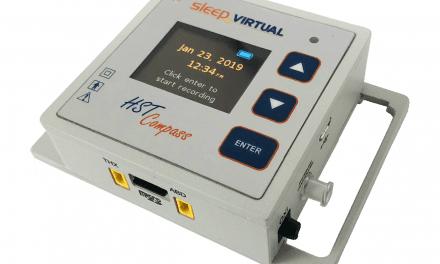Strategies for successful use of heated humidification include maximizing comfort of the CPAP mask, while preventing excess condensation in the delivery tube.

Current assumptions and clinical practice point to increased use of heated humidity during diagnostic sleep studies and as part of the initial prescription of CPAP therapy. Key concepts about humidification of the PAP delivery system reflect both recent research and current clinical experience. Four ideas about humidification and CPAP therapy seem to be most relevant. First, due to its well-known ability to ameliorate nasal dryness and problems with the nasal or upper airway mucosa, heated humidification of the CPAP circuit appears to be much more therapeutic than either cold passover humidification or no humidification at all.1-3 Second, it appears that humidification should usually be ordered with the initiation of CPAP, since any delay in improving patient comfort and tolerance may cause patients to abandon therapy.4,5 Third, excess condensation or “rainout” in the CPAP delivery tube can lower applied inspiratory pressure by as much as ±3 cm H2O to ±6 cm H2O pressure, making the delivered pressure less than that prescribed to abolish all respiratory events.6 Finally, some patients appear to have increased risk of upper airway infections due to inadequate cleaning of their masks, hoses, and humidification chambers.7
CPAP Therapy and Humidity
Compliance with CPAP therapy is difficult when patients have problems such as nasal dryness, dryness in throat and mouth, sore tongue, nasal stuffiness, and nosebleeds. Nasal or upper airway dryness is a side effect of unhumidified CPAP use and is a common reason people terminate an otherwise beneficial therapy.8
When we breathe through our nose, the air we inhale is naturally warmed, filtered, and humidified. Problems seem to occur when delicate tissue inside the upper airway changes due to the increased airflow and breathing air that is dryer than normal. A medical assessment is necessary to determine the actual condition of each patient’s nose and throat, but the addition of a heated humidification chamber to CPAP delivery systems can provide the necessary warm, moist air that the upper airway mucosa seems to need.
Sometimes nasal stuffiness due to rhinitis, sinusitis, or allergies can be relieved by prescription nasal sprays or medications. These may make it easier to breathe during CPAP treatments, but casual assessment during all-night polysomnograms seems to indicate that heated humidity may also reduce nasal stuffiness in some patients and cause it in others. This may need to be researched more carefully before any conclusions are drawn from anecdotal information, however. At least one study9-11 indicates that irritation of the nasal mucosa can be reduced and nasal airway resistance can be decreased simply by using heated humidification to increase the relative humidity of inspired air.
Indications and Contraindications
During CPAP treatments, heated humidification seems to be the best choice for most patients to increase both comfort and compliance.1-5 With that in mind, when are cold passover humidification or no humidification appropriately used or recommended with CPAP delivery systems? Since as many as 40% of individuals using nasal CPAP are affected by nasal congestion, dry nose, and dry throat or mouth,2 it seems more than just intuitively obvious that humidification may help reduce this symptomatology.
Although much of this experiential information seems to be somewhat anecdotal, the choice of heated or cold humidification, or no humidification at all, may perhaps best be left up to each patient to determine and utilize as necessary based on their own experience with the therapy. As sleep specialists, we can recommend humidity as a therapeutic option to decrease nasal, throat, and mouth dryness associated with CPAP use; however, patients need the freedom to choose which safe choices seem to be most experientially effective for them and provide the fewest symptoms and side effects.
If a patient increasingly develops nasal or upper airway infections due to inadequate cleaning and disinfection of their delivery systems, then perhaps humidification is contraindicated for that patient. Likewise, certain patients may feel that it is more difficult to breathe when extra moisture is added to their CPAP delivery systems because of side effects of their existing medical conditions (asthma, emphysema, or chronic obstructive pulmonary disease). The optimum scenario is probably for physicians and sleep specialists to discuss implications with patients and make decisions about use of humidification on a case-by-case basis—and make changes to the therapy if circumstances indicate the necessity to do so.
Finally, delivered mask pressure may be different than expected when using heated humidity with CPAP delivery systems. The applied mask inspiratory pressure may be reduced by water condensation in the delivery tubing. In 2000, in an experiment performed by Bacon et al6 at the University of Utah Medical Center, CPAP machines were tested under a variety of simulated clinical conditions, including condensation or “rainout” in the delivery tube. The study results indicated that water condensation can produce huge pressure deviations—inspiratory pressure could be as much as 3.5 to 5.6 cm H2O below the set pressure and expiratory pressure 0.7 to 3.5 cm H2O above the set pressure.
Conclusion
Optimistically, a 1999 study by Pepin et al12 indicates that CPAP compliance rates were between 65% and 80% in Europe and about 46% in the United States. A more disturbing and more recent study by Engleman and Wild in 20034 found that internationally anywhere from 5% to 50% of sleep apnea/hypopnea syndrome (OSAHS) patients for whom CPAP was recommended either rejected the treatment option when offered or discontinued it within the first week of therapy. It is beyond the scope of this article to attempt resolution of all CPAP compliance issues; however, some compliance issues can likely be resolved simply by increasing the humidity in the air breathed during CPAP treatments. Since the relative humidity of air delivered via CPAP systems is approximately 20% lower than that of unhumidified room air,3 adding humidity to the treatment seems to be a natural and obvious thing to do. This may improve patient comfort and compliance with CPAP therapy.
Ideal settings for humidification chamber heaters depend on the temperature and humidity of the air used during CPAP treatment. Unfortunately, depending on the region, season, and whether air conditioning is used, these settings may vary. The goal is to maximize comfort at the mask, while preventing excess condensation in the delivery tube. At the simplest level, patient experience will dictate the changes necessary to reduce upper airway dryness problems yet prevent excess condensation.
Patients may need to change the amount of heat applied depending on the time of year and ambient temperature and humidity conditions. If there is water pooling in the delivery tube, there is probably excess condensation. In addition, the mask may be wet and the CPAP delivery system may be making gurgling or spitting sounds. Under these circumstances, make sure that the humidification chamber is lower than bed level so water will pool below the patient, and turn down the heater control setting to reduce condensation.
Strategies for successful use of heated humidification include: always place the delivery tube lower than the patient’s head so moisture cannot run into the mask; empty any remaining water from the humidification chamber and delivery tubing every morning so it does not provide an environment favoring bacterial growth; disinfect CPAP masks and humidification chambers once per week, according to manufacturer’s instructions, to help prevent upper airway infections; and patient experience with CPAP therapy may determine whether heated humidity is necessary all the time, or under certain conditions. Heated humidity may be contraindicated if patients experience difficulty breathing or increased development of upper airway infections.
Daniel B. Carlsen is a polysomnographic technologist for the Minnesota Sleep Institute (MSI), working out of the High Pointe Health Campus in Lake Elmo, Minn. He can be reached at [email protected].
References
1. De Aroujo MTM, Vieira SM, Vasquez EC, Fleury B. Heated humidification or face mask to prevent upper airway dryness during continuous positive airway pressure therapy. Chest. 2000;117:142-147.
2. Richards D, Cistulli R, Unger R, Berthon-Jones M, Sullivan C. Mouth leak with nasal CPAP increases nasal airway resistance. Aust NZ J Med. 1994;24:480.
3. Rakotonanahary D, Fleury-Pelletier N, Gagnadoux F, Fleury B. Predictive factors for the need for additional humidification during nasal continuous positive airway pressure therapy. Chest. 2001;119:46-65.
4. Engleman HM, Wild MR. Improving CPAP use by patients with the sleep apnoea/hypopnoea syndrome (SAHS). Sleep Med Rev. 2003;7:81-99.
5. Malhotra A, Ayas NT, Epstein LJ. The art and science of continuous positive airway pressure therapy in obstructive sleep apnea. Curr Opin Pulm Med. 2000;6:490-495.
6. Bacon JP, Farney RJ, Jensen RL, Walker JM, Cloward TV. Nasal continuous positive airway pressure devices do not maintain the set pressure dynamically when tested under simulated clinical conditions. Chest. 2000;118:1441-1449.
7. Sanner BM, Fluerenbrock N, Kleiber-Imbeck A, Mueller JB, Zidek W. Effect of continuous positive airway pressure therapy on infectious complications in patients with obstructive sleep apnea syndrome. Respiration. 2001;68:483-487.
8. CPAP Therapy & Humidity. The Lung Association of Canada Web site. Available at: http://www.lung.ca/sleepapnea/ newsletter/2001.12.html. Accessed October 15, 2003.
9. Constantinidis J, Knobber D, Steinhart H, Kuhn J, Iro H. Fine-structural investigations of the effect of nCPAP-mask application on the nasal mucosa. Acta Otolaryngol. 2000;120:432-437.
10. Hayes M, McGregor F, Roberts D, Schroter R, Pride N. Continuous nasal positive airway pressure with a mouth leak: effect on nasal mucous blood flux and nasal geometry. Thorax. 1995;50:1179-1182.
11. Massie CA, Hart RW, Peralez K, Richards GN. Effects of humidification on nasal symptoms and compliance in sleep apnea patients using continuous positive airway pressure. Chest. 1999;116(2):403-408.
12. Pepin JL, Krieger J, Rodenstein D, et al. Effective compliance during the first 3 months of continuous positive airway pressure: a European prospective study of 121 patients. Am J Respir Crit Care Med. 1999;160:1124-1129.





